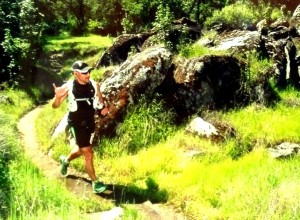new posts in all blogs
Viewing: Blog Posts Tagged with: hill running, Most Recent at Top [Help]
Results 1 - 5 of 5
How to use this Page
You are viewing the most recent posts tagged with the words: hill running in the JacketFlap blog reader. What is a tag? Think of a tag as a keyword or category label. Tags can both help you find posts on JacketFlap.com as well as provide an easy way for you to "remember" and classify posts for later recall. Try adding a tag yourself by clicking "Add a tag" below a post's header. Scroll down through the list of Recent Posts in the left column and click on a post title that sounds interesting. You can view all posts from a specific blog by clicking the Blog name in the right column, or you can click a 'More Posts from this Blog' link in any individual post.
.jpeg?picon=3498)
By: Cait,
on 8/30/2014
Blog:
Cait's Write...
(
Login to Add to MyJacketFlap)
JacketFlap tags:
tips,
running,
goals,
training,
cross country,
workouts,
hill running,
treadmill running,
cross training,
Add a tag
Runners are constantly climbing. It’s in our nature to always have a goal we’re working towards, always wanting to push ourselves to do better. Whether it be chasing new PR’s, challenging yourself to expand your race distance range, or even after we’re past our ‘PR-PR’ years, redefining the times and bests (weekly, yearly, masters, etc.) bests.
Diversity. Fitting as it is now cross country season that we talk about diversifying your running and climbs. Cross country thrives on both. I’ve done posts on just how awesome hills are at improving your strength and power, which translates to speed. What I haven’t talked too much on are prolonged hill climbs.

The long climb, yup. We’re talking taking your tempo runs to the trail, or inclined treadmill if you don’t have a stretch long enough outside. I’ve previously featured the man-beast that is Michael Wardian and he’s no stranger to treadmill running.
While he’s one of the World’s best ultra and trail runners, a major chunk of his miles are done on the treadmill so he can fit his runs in around his family’s (namely his kids’!) schedules. Wardian loves a good, long climb.
He makes sure to do hill work a few times a week and, “for me that means hours of running up vertical inclines, sometimes fast, sometimes just a long grind, but always pushing to get better.” Wardian is an ultra runner after all.
Another big fan of prolonged uphill runs is Sage Canaday, a staple workout for him is an uphill tempo run. Canaday is another World leading ultra runner [check out my feature on him HERE], residing in Boulder, CO he has no shortage of trails to mountain goat up.

Yo, that’s my rockstar dad running 50 miles! :)
Even if you’re not one of the best in the World, taking advantage of prolonged hill climbs will benefit you.
Coach Brad Hudson of the Hudson Training Systems, coaching both elites and all levels of runners, regularly incorporates uphill tempo runs for his runners.
Try It:
Take your next scheduled tempo run to a hill, keep the distance the same and adjust based on effort. [Captain Obvious: Your times aren't going to mean much, so go off of effort.] I’d suggest going 4-5 miles.
No hill? No problem…take it to the treadmill. For a moderate climb set the grade to 4% for your tempo run and again, go off of effort. Do your warm-up and cool-down at 1.5%, as that’s the equivalent to running outside on the flats…after you jack that incline up and finish your tempo run, upon lowering you’ll see just how much ‘easier’ the same pace will feel at 1.5%!
If you’re looking for a steeper incline, Captain Obvious tells us you can just elevate the treadmill. 
Another twist courtesy of Coach Hudson would be to make your hill climb tempo progressive, begin the workout at a 2% grade and have it up to 6% by the time you finish.
Life’s a climb after all. For runners, we take that both figuratively and literally. 
——–
More workout posts HERE
Need some motivation to get ‘er done…look HERE
Sweat hard, recover hard… #SweatsintheCity style, Baby!
——–
1) Are you running cross country season?
2) How do you incorporate hill work into your training?
3) Have you done incline tempo/threshold work?

Trail running makes you strong. It can also make you faster. “But wait,” you think, “I look down at my watch Garmin afterwards and the times are slower!” Ahhh…it all comes back to effort, My Dears, effort.
Hills take a LOAD more effort running up than running on the flats. #lessonfromcommonsense Haha. Force those legs of yours to put in the extra effort needed to get up those inclines thought and you’ll build power. Now a lesson in running mathematics:
Power = Strength = Speed

Blast up those hills and the second you take it to the track or flats, you’ll be thinking how much ‘easier’ it feels. This summer, take it to the trails (the right way) and you’ll come out stronger, faster, and ready to kick butt. It’s not just about ‘base building’ it’s about ‘power building’.
5 Ways to Do Your Power Building Trail Running RIGHT
1) Get Efficient:
You’re not doing hills right if you’re
hunched over like Quasimodo. Hills make it even more important you hold proper form. Check out my post on form
HERE and when taking it to the hills remember:
* Stand Up TALL: Keep that torso straight!
* Don’t Lean: Don’t lean too far into the hill, keep your center of gravity above your hips; your hips will naturally be SLIGHTLY leaning into the hill, but you should think in your mind about standing up straight because quite honestly you’ll probably ‘feel’ like you’re leaning WAY back behind you but in reality are where you need to be. Focus on staying upright.
* Shorten Stride: Keep the same effort running up the hill but shorten your stride. Focus on the faster turn-over and power up that hill!
2) Eyes Ahead: Keep your eyes focused on the top of the hill, you want to power all the way UP and THROUGH the crest. Too many runners make the mistake of powering up and stopping juuuuust short of the crest which means they lose all that momentum they worked SO hard for getting up. Run THROUGH the hill so you can use that momentum to power down it.
3) Blasts vs. Endurance: Just like track and flat speedwork, hill running workouts should be tailored to match the goal for the day’s workout. Short 10-30 second hill blasts can be thought of like plyometric work. It will REALLY build that base speed, it’s all fast twitch; so remember to take FULL recovery for short blasts, as is the law of the sprinters and taxing the anaerobic energy system. Longer hill repeats and doing tempo workouts on a hilly course will further build that endurance and strength so when you take it to the flats the same EFFORT will yield much faster times. It’s always cool to step from the hills to the track, look at the watch and surprise yourself, no? 
4) Rolling and Exploring: Even doing your easy days on the trails will build power. Over time the ups and downs make you stronger; it’s important to keep your easy day EFFORT easy though so you’re still actually recovering. So again, ignore what the watch says and run for effort.
5) Downhill Running: It’s important to remember that everything that goes up, goes down. #duh Running downhill puts a lot of stress on the body and as any Boston Marathon runner can tell you downhills can REALLY do a number on those quads. Downhill running isn’t ‘easy peasy’ on the body. So if you’re training for a race with lots of downhills it’s smart to practice running downhill. If you’re prone to injury beware, because the extra pounding can cause knees and ankles to get cranky. Final tip on running downhill: don’t FIGHT it. Relax, let gravity help you, and don’t try to fight it…roll with it, Runner Babes.

So if you’re not sold on hills and exploring trails, and that they will make you faster, yet…just go to Instagram and check out some of those nature pix those avid trail runners are posting! The miles will fly by. Go out…explore, adventure, LOVE the run!
——–
CHECK IT OUT!! Ezzere made Competitor’s list for TOP fitness tees!! Wahooo…the Peacock Runner Tee, sitting at number 3 on the slideshow. 
——–
1) Best, most amazing trail run you’ve even been on?
Nisene Marks Park in Aptos, CA. Go there.
2) Favorite hill workout?

Because we’ve ALL had those prickly bush fantasies in the middle of a workout or race. “I’ll bet hucking myself into that tangle of nettles will be a LOT less painful than what I’m doing now.”

It may not always be a prickly bush, but the mind certainly has a crazy way of looking for any excuse to get you to stop running. Fighting those ‘excuses’ and telling yourself to IGNORE that whiney voice inside your head is something ALL runners deal with. Constantly.
We know that complainer, that voice telling us that we can’t, will always be there. We start every race and workout aware that the time will come when the pain sets in, but we ALSO tell ourselves that we CAN push much further past what that whiney, compliany, snot-nosed little voice tells us.
Run mentally tough…abstain from hucking yourself into that prickly bush. Well, at least until you’ve gotten through all the repeats, then, well, do what you will. 
———
Be a GAMER: How to be confident going into workouts and races
Master Your Nerves: How to use pre-race nerves to your advantage
More posts on mental toughness HERE
More Runner’s Strip Cartoon Movie Shorts HERE
———-
1) What was your last ‘prickly bush fantasy’?
A bush.
2) What are some other funny thoughts/fantasies you’ve had during workouts or races?
3) What has become the best way for you to stay mentally tough during workouts and races? What’s your most-used tool?

Life’s just better with color.

——–
More running motivation HERE
——–
1) Where do most of your runs take you? ie: roads, trail, track, etc.
2) What are typical Friday and weekend night plans for you?
3) Running brings color into my life by…

Unless you’re racing on a track, there’s SOME kind of terrain you’ll need to be prepared for come gun-time. Even during track season athletes have much to gain from varying the terrain on their workouts.
- Power and Speed: Hills build strength and when taken to flats that translates to speed. That same kind of logic applies to doing repeats on grass, the times may be ‘slower’ but you’re working harder and building strength.
- Injury Prevention: Running on softer, more forgiving surfaces helps reduce impact and thus lowers your chances for injuries in the long-term.
- Diversity: Running is a very repetitive action and mostly only working in a single, horizontal plane. At least by varying things slightly you’re able to give your body a bit of diversity; if you fail to do this, smaller muscles get weak and imbalances become injuries in waiting.
Those are all general reasons why mixing up your running terrain is a good idea, but if you know your actual race course will have key elements you’ll need to be prepared for, it’s even more important to introduce those same obstacles in training.

Hilly Courses
- Uphill Repeats: It take power to get up those hills; including uphill repeats into your routine may seem like an obvious but not all runners actually DO hill work, or they don’t mix-up the kind of work that they do. Think of hills in a three-pronged approach, similar to your regular running workouts. 1) Do 100-200 meter hill bursts, allow for full recovery between each repeat; this is your speed session for the week. 2) Longer, 600-1600 meter hill repeats for your endurance-focused interval sessions. You could also do tempo runs uphill (on a treadmill set on a grade if you don’t have an actual course). 3) Including rolling hills into your easy days ‘sneaks’ hill work in.
- Downhill Repeats: Many can overlook just how taxing a lot of downhill on your race course can be. If your race has a significant amount of downhills (Hello, Boston Marathon!), be sure to get used to running on the decline; your quads will be working even if you don’t ‘feel it’ right away. You can include some downhill repeats in your training; just be careful in terms of injury because downhill running does increase the forceful pounding of running.
- Form: Running hills makes it even more important to have good form; when running uphill maintain the same effort that you would but decrease your stride length. When running downhill, make sure that you’re not tensing up and causing yourself to ‘brake;’ rather, relax and let the momentum of the decline help do some of the work for you.

Trail running
- Ankles and lower legs: Trail running is about as diverse as running can get, twists, turns, awkward foot-plants aplenty. Here is where you need to be sure your ankles and feet are used to landing in various positions. The way to do that is, well, running trails, taking turns, and including mobility work outside of running.
- Core and Mobility: To reduce your risk for injury when running, you want to have a strong core, be flexible, and have as much range of motion as possible. Schedule time for strength training, dynamic stretching, and drills; not only will it help safeguard you against injuries it will improve your running performance.
Tracks, Roads and the Elements
- Tangents: Some math logic here, but running longer adds more time to your race results. Road races are measured off of the shortest possible marked distance, so look for those tangents and don’t run wider around turns than you have to. On the track, unless you’re going to be boxed in, do your best to not needlessly wander into outer lanes.
- Drafting: Even on the calmest of days drafting makes a difference, mentally it’s much ‘easier’ to sit behind someone else and let them do the work. If it’s especially windy, find a body and tuck in behind them!
- Weather Conditions: The conditions of race day can make a HUGE difference in your performance; not only should you take these into consideration for your race-day pacing goals but train in the same kind of conditions. For cold races be extra certain you do a full warm-up to make sure your muscles are properly warm and ready to hit those faster paces.
Until the day that all races are held on treadmills, runners should be mixing up the terrain of their workouts and runs. By tailoring your training to your specific race course you’ll be setting yourself up for even better results. And hey, who doesn’t want to run that much faster and have a bit of an edge over their competition? 
1) How do you train for your course? If it’s for the track, how do you add diversity to your workouts?
2) Do you prefer road races, track races, cross-country, or trail races?
3) How do you plan, adapt, or prepare for various weather conditions?




![]()
![]()








